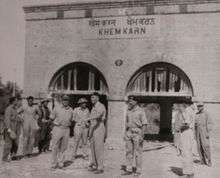Khemkaran
| Khemkaran Khem Karan | |
|---|---|
| city | |
|
Destroyed Pakistani tanks arranged at "Patton Nagar" | |
 Khemkaran Location in Punjab, India | |
| Coordinates: 31°10′N 74°40′E / 31.16°N 74.66°ECoordinates: 31°10′N 74°40′E / 31.16°N 74.66°E | |
| Country |
|
| State | Punjab |
| District | Tarn Taran |
| Region of Punjab | Majha |
| Population (2001) | |
| • Total | 11,938 |
| Languages | |
| • Official | Punjabi |
| Time zone | IST (UTC+5:30) |
Khem Karan (Punjabi: ਖੇਮਕਰਨ) is a town and a nagar panchayat in Tarn Taran district of Patti tehsil of the Majha region of Indian state of Punjab. It was the site of a major tank battle in 1965 resulting it also being known as the graveyard of tanks.[1]
The 1965 Indo-Pakistani War was witness to the largest tank battle (Chawindah) in military history between World War II and 1965. The battle led to the creation of Patton Nagar (or Patton City) at the site of the battle viz., Khemkaran.
History
Khem Karan is an old city. Guru Tegh Bahadur (1621–1675) visited it. It used to be in Lahore district before partition of India. It became a part of Amritsar district after the partition. Now it is in Tarn Taran district. Many of the town's residents migrated from nearby villages in modern Pakistan between 1947 and 1965, such as Nathuwala, Qadiwind, Rohiwal, and Sehjra. The towns Muslim residents migrated primarily to the city of Kasur, 8 km away in Pakistan.
The town used to be easily accessible to the city of Kasur, Pakistan only 8 km away, and to Ferozepur 35 km away, but since India and Pakistan enacted border controls in 1953, the residents of the Khem Karan have been essentially cut off from both towns - Kasur lies in Pakistan, while the road to Ferozepur cuts through Pakistan, resulting in a detour of an extra 70 kilometre's drive. The townpeople, and those from surrounding villages, must now travel a long distance to Amritsar or Tarn Taran to procure any major goods, causing great inconvenience, and economic stagnation.
India-Pakistan war of 1965

The tank battles of 1965 form part of military history as the most intense armored battles between the end of World War II and the 1991 Gulf War. Close to a thousand tanks, on both sides, took part in the pitched battles and offensives. At the start of the war, Indian strength was limited to one armored division and one independent armoured brigade, along with six armoured regiments supporting infantry divisions. Pakistan had two armored divisions, with the then very modern M-48 Patton tanks. India had an equivalent tank in the Centurion, but their strength was limited to only four armored regiments.
Patton Nagar
Near the Bhikhiwind village, a strip of land was called Patton Nagar for a short while in 1965.[2] It was here that more than 97 tanks of the Pakistani army were displayed at the end of the September India-Pakistan conflict. The Pakistan Army tanks were captured at the Battle of Asal Uttar by India's 4 Mountain Division and it became a memorial to the Pakistani tanks being bogged down in the marshes during the 1965 War. The tanks were displayed for some time after which they were shipped to various cantonments and army establishments in India for display as war trophies.
97 tanks captured at Assal Uttar

Six Pakistani Armoured Regiments took part in the battle, namely the 19th Lancers (Patton), 12th Cavalry (Chaffee), 24th Cavalry (Patton) 4th Cavalry (Patton), 5th Horse (Patton) and 6th Lancers (Patton).
The Indian forces in the field that day consisted of three Armoured regiments with tanks of varying quality, the Deccan Horse (Shermans), 3rd Cavalry (Centurion) and the 8th Light Cavalry (AMX-13). The battle was so fierce and intense that at the end of the war, the Pakistani 1st Armored division had lost about 97 tanks in destroyed/damaged or intact condition. This included 72 Patton tanks and 25 Chaffees and Shermans. 32 of the 97 tanks, including 28 Pattons, were in running condition.
Demographics
As of 2001 India census,[3] Khem Karan had a population of 11,940. Males constitute 55% of the population and females 45%. Khem Karan has an average literacy rate of 47%, lower than the national average of 59.5%: male literacy is 54%, and female literacy is 39%. In Khem Karan, 15% of the population is under 6 years of age.
Places of interest
In this village is the mausoleum (mazaar) of a Sufi saint known as Pir Baba Sheikh Brahm. Twice in a year a mela is held here.
References
| Wikimedia Commons has media related to Khemkaran. |
- ↑ Stephen Peter Rosen. Societies and Military Power: India and Its Armies. Cornell University Press. p. 246. ISBN 0-8014-3210-3.
- ↑ Steve Zaloga, Jim Laurier (1999). The M47 and M48 Patton Tanks. Osprey Publishing. p. 33. ISBN 1-85532-825-9. Retrieved 2009-03-12.
- ↑ "Census of India 2001: Data from the 2001 Census, including cities, villages and towns (Provisional)". Census Commission of India. Archived from the original on 2004-06-16. Retrieved 2008-11-01.
